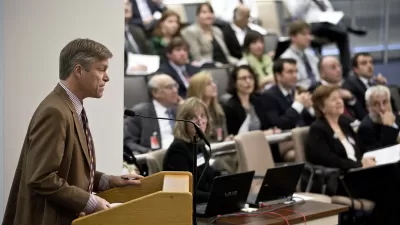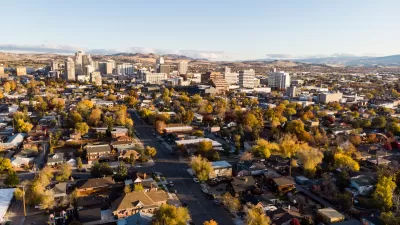In this era of increased inequality, socially-blind urban planning is morally questionable. Specifically, on the issue of homelessness in America, there are three problems to which planners need to pay particular attention.

The contrast between prosperity and poverty is most dramatic in the harshness of inclement weather. In San Diego this past weekend, while the storms resulting from El Nino lashed at the city, I drove through East Village, a neighborhood that contains one of the largest concentrations of homeless in the region. It is also the epicenter of Downtown’s new construction boom.
Amidst the broken tree branches and debris, scattered and soaked in the storm water were large black trash bags that homeless people had used to protect themselves. I saw helplessness in the eyes of an elderly couple as the rain whipped at them from every direction, drenching their belongings. An orderly line of about a half dozen people waited on the sidewalk for their turn to use the portable bathrooms, seemingly numb to the pouring rain. A series of blue tents clustered under the freeway bridge, sharing a tarp, and a young woman was braving the gusty winds to stand at that intersection, her hands clenching a soaked cardboard sign that simply read, “Homeless, Hungry.”
In the background, I saw construction cranes idling in the sky above them, poised to continue building a teal-colored luxury condominium tower with yellow and white accents.
America’s Finest City has an ugly problem.
The homeless population in San Diego is among the four largest in the nation and getting worse, with over 8,700 people living without shelter. And while this kind of weather is rare in San Diego, it is not new, yet even after anticipating the storm for months and knowing the severity of our homelessness problem, there was marginal galvanization of resources by local government. Simultaneously, the city was able to commit hundreds of millions of dollars in public funds for supporting downtown development with an expanded convention center and a Chargers stadium that the NFL does not want, all of which will likely be built in the very neighborhood these people call home.
In this era of increased inequality, socially-blind urban planning is morally questionable. Specifically, on the issue of homelessness in America, there are three problems that planners need to pay attention to:
Social impacts of planning are relegated to the margins. Planners often consider development projects from the sterile perspective of social value-free growth. Social issues such as homelessness appear as ancillary considerations, footnoted, or completely omitted in normal project planning and permitting processes. Social issues such as homelessness appear as ancillary considerations, footnoted, or completely omitted in normal project planning and permitting processes. I have served almost three years as a board member of San Diego’s downtown planning and permitting agency, yet not once has the issue of displacement been addressed by the agency when approving an unsubsidized housing project. Not once has a “vacant lot” that was at the time housing homeless people been treated as anything but developable dirt. Most developers proposing luxury housing projects in downtown get away providing no inclusionary housing and mandatory minimum fees. And there is a concerted effort in the street-front design of these towers to ensure that the homeless cannot sit, sleep or stay in the area.
FULL STORY: Socially-Blind Urban Planning

Trump Administration Could Effectively End Housing Voucher Program
Federal officials are eyeing major cuts to the Section 8 program that helps millions of low-income households pay rent.

Planetizen Federal Action Tracker
A weekly monitor of how Trump’s orders and actions are impacting planners and planning in America.

Canada vs. Kamala: Whose Liberal Housing Platform Comes Out on Top?
As Canada votes for a new Prime Minister, what can America learn from the leading liberal candidate of its neighbor to the north?

Wildlife Rebounds After the Eaton Fire
Following the devastation of the Eaton Fire, the return of wildlife and the regrowth of native plants are offering powerful signs of resilience and renewal.

LA to Replace Inglewood Light Rail Project With Bus Shuttles
LA Metro says the change is in response to community engagement and that the new design will be ready before the 2028 Olympic Games.

Paris Voters Approve More Car-Free Streets
Paris Mayor Anne Hidalgo says the city will develop a plan to close 500 streets to car traffic and add new bike and pedestrian infrastructure after a referendum on the proposal passed with 66 percent of the vote.
Urban Design for Planners 1: Software Tools
This six-course series explores essential urban design concepts using open source software and equips planners with the tools they need to participate fully in the urban design process.
Planning for Universal Design
Learn the tools for implementing Universal Design in planning regulations.
Central Transportation Planning Staff/Boston Region MPO
Heyer Gruel & Associates PA
Institute for Housing and Urban Development Studies (IHS)
City of Grandview
Harvard GSD Executive Education
Toledo-Lucas County Plan Commissions
Salt Lake City
NYU Wagner Graduate School of Public Service




























